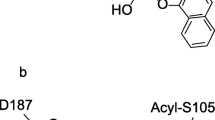Abstract
Substrate specificity of the acyltransferase activity of the lipase (EC 3.1.1.3) fromCandida parapsilosis CBS 604 was studied in aqueous media. The specificity toward both acid and alcohol parts of a large number of acylglycerols and aliphatic esters was investigated. This lipase showed a high activity in the presence of esters with long-chain fatty acids and particularly unsaturated fatty acids with acis-Δ9 double bond. It was observed that the activity profile depended not only on the alcohol part of the acyl ester, but also on the temperature of the reactant medium. The best lipid substrates had their melting point between −40 to +20°C, 14 to 18 carbon atoms in the acyl group and 1 to 4 carbon atoms in the alkyl group. The enzyme, defined as an acyltransferase in a previous paper, showed a high affinity for primary and secondary alcohols with a short carbon chain (1 to 5 carbon atoms) as acyl acceptors. The influence of free alcohols in the reactant medium on the hydrolysis and alcoholysis activities of the enzyme is discussed. Two phenomena seem to be involved, depending on the alcohol: competition with water for the acyltransfer reaction and lipid substrate dilution when the alcohol places at the oil/water interface.
Similar content being viewed by others
Abbreviations
- FA:
-
fatty acid
- GC:
-
gas chromatography
- HPLC:
-
high-performance liquid chromatography
- TLC:
-
thin-layer chromatography
References
Van der Paadt, A., Keurentjes, J.T.F., Sewalt, J.J.W., van Dam, E.M., van Dorp, L.J., and van't Riet, K. (1992) Enzymatic Synthesis of Monoglycerides in a Membrane Bioreactor with an Inline Adsorption Column.J. Am. Oil. Chem. Soc. 69, 748–754.
Tavridou, A., Avranas, A., and Arzoglou, P. (1992) A Mathematical Approach to Lipolysis Based on the Relationship of Physicochemical and Biochemical Data,Biochem. Biophys. Res. Comm. 186, 746–752.
Sugiura, M., and Isobe, M. (1975) Studies on the Lipase ofChromobacterium viscosum IV. Substrate Specificity of a Low Molecular Weight Lipase,Chem. Pharm. Bull., 23, 1226–1230.
Briand, D., Dubreucq, E., and Galzy, P., (1994) Enzymatic Fatty Esters Synthesis in Aqueous Medium with Lipase fromCandida parapsilosis (Ashford) Langeron and Talice,Biotechnol. Lett. 16, 813–818.
Briand, D., Dubreucq, E., and Galzy, P. (1995) Functioning and Regioselectivity of the Lipase ofCandida parapsilosis (Ashford) Langeron and Talice in Aqueous Medium. New Interpretation of Regioselectivity Taking Acyl Migration into Account,Eur. J. Biochem. 228, 169–175.
Galzy, P. (1964) Etude Génétique et Physiologique du Métabolisme de l'Acide Lactique ChezSaccharomyces cerevisiae Hansen,Ann. Technol. Agric. 13, 109–259.
Riaublanc, A., Ratomahenina, R., Galzy, P., and Nicolas, M. (1993) Peculiar Properties of Lipase fromCandida parapsilosis (Ashford) Langeron and Talice,J. Am. Oil Chem. Soc. 70, 497–500.
Biehn, G.F., and Ernsberger, M.L. (1948) Polyvinyl Alcohol as an Emulsifying Agent,Ind. Eng. Chem. 40, 1449–1453.
Van Autryve, P., Ratomahenina, R., Riaublanc, A., Mitrani, C., Graille, J., and Galzy, P. (1991) Spectrophotometry Assay of Lipase Activity Using Rhodamine 6G.Oléagineux 46, 29–31.
Weast, R.C. (1965–1966)Handbook of Chemistry and Physics, 46th edn., The Chemical Rubber Co., Cleveland.
Gunstone, F.D., Harwood, J.L., and Padley, F.B., (1986)The Lipid Handbook, 1st edn., Chapman and Hall, London, New York.
Légier, V., and Comeau, C. (1992) Continuous Synthesis of Esters by Cell-Bound Fungal Lipases in an Organic Solvent,Appl. Microbiol. Biotechnol. 37, 732–736.
Okumura, S., Iwai, M., and Tsujisaka, Y. (1979) Synthesis of Various Kinds of Estery by Four Microbial Lipases,Biochim. Biophys. Acta 575, 156–165.
Jensen, R.G., Dejong, F.A., and Clark, R.M. (1983) Determination of Lipase Specificity,Lipids 18, 239–252.
Macrae, A.R., and Hammond, R.C. (1985) Present and Future Applications of Lipases,Biotechnol. Gen. Bioeng. Rev. 3, 193–217.
Jencks, W.P. (1969)Catalysis in Chemistry and Enzymology, pp. 289–291. Dover Publications, New York.
Brockerhoff, H., and Jensen, R.G. (1974)Lipolytic Enzymes, pp. 10–24, Academic Press, New York, San Francisco, London.
Penasse, L. (1974)Les Enzymes, Cinétique et Mécanisme d'Action, pp. 115–144, Ed Masson et Cie, Paris.
Author information
Authors and Affiliations
About this article
Cite this article
Briand, D., Dubreucq, E., Grimaud, J. et al. Substrate specificity of the lipase fromCandida parapsilosis . Lipids 30, 747–754 (1995). https://doi.org/10.1007/BF02537802
Received:
Revised:
Accepted:
Issue Date:
DOI: https://doi.org/10.1007/BF02537802



